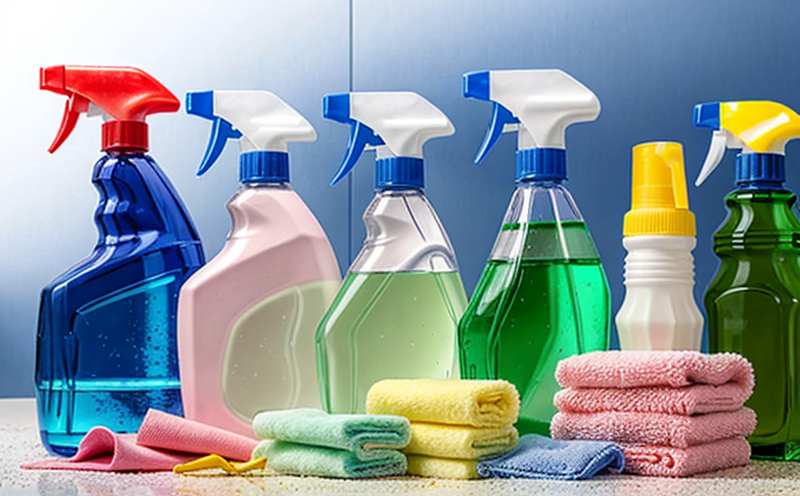Eye Irritation Testing of Detergents
Eye irritation testing is a critical component in ensuring consumer safety and compliance with international standards. For cleaning products and detergents, this test evaluates the potential for eye discomfort or damage when in contact with the ocular surface. Eye irritation can lead to temporary or permanent vision impairment, which makes it essential to perform thorough tests before any product reaches the market.
The testing process involves exposing human corneas (or rabbit eyes) to the test substance under controlled conditions. The severity of the reaction is then scored using standardized criteria. This helps in determining whether a detergent meets the required safety standards set by regulatory bodies such as ISO, ASTM, and EN.
When conducting eye irritation tests on detergents, Eurolab employs various methods including the Draize test (rabbit eye method) and the Schirmer tear production test. The Draize test is widely recognized for its ability to assess the potential of a substance to cause ocular damage or discomfort. It involves instilling the test solution into the conjunctival sacs of rabbits and observing any changes in 16 hours, 24 hours, and 48 hours post-exposure.
The Schirmer tear production test measures how much water is secreted from the eye to lubricate it. This can indicate whether a detergent causes excessive dryness or discomfort in the eyes, which are symptoms of irritation. By combining these tests, Eurolab ensures comprehensive evaluation and accurate results.
Specimen preparation for this type of testing involves obtaining fresh rabbit eyes, which are then used under sterile conditions to avoid contamination. The test solution is prepared according to specific protocols outlined by international standards such as ISO 10993-11:2018. After the exposure period, the corneas or eyes are examined for signs of irritation, including redness, swelling, and discharge.
The results of these tests are reported using a standardized scoring system that quantifies the severity of any observed reactions. This ensures consistency across different studies and facilitates easier interpretation by regulatory bodies and consumers alike. Compliance with international standards like ISO 10993-11:2018 guarantees that the testing process is both rigorous and reliable.
Real-world applications of this service include ensuring product safety during development stages, validating claims made on product labels, and meeting legal requirements in various countries around the world. By performing these tests early in the product lifecycle, manufacturers can make necessary adjustments to formulations before finalizing products for launch. This not only protects consumers but also helps companies avoid costly recalls or legal actions.
Understanding the importance of eye irritation testing is crucial for those involved in the development and regulation of cleaning products and detergents. Properly conducted tests provide valuable insights into potential risks, enabling informed decision-making throughout the product lifecycle.
Benefits
- Enhanced Product Safety: Ensures that any new detergent formulation poses minimal risk to end users’ eyes.
- Compliance Assurance: Helps manufacturers meet stringent international standards such as ISO 10993-11:2018.
- Potential Reduction in Legal Risks: Avoids product recalls due to safety concerns, saving time and resources.
- Better Consumer Trust: Establishes a reputation for quality and reliability among consumers who value safe products.
- Competitive Advantage: Demonstrates commitment to high standards of quality and compliance which can differentiate your brand in competitive markets.
Implementing robust eye irritation testing protocols ensures that cleaning products and detergents are not only effective but also safe for use. By adhering to these stringent tests, Eurolab helps clients protect their brands while ensuring the well-being of consumers.
Eurolab Advantages
At Eurolab, we offer a range of advantages that make us leaders in eye irritation testing for detergents:
- State-of-the-Art Facilities: Our laboratories are equipped with the latest technology and equipment to conduct precise and accurate tests.
- Expertise: Our team comprises highly skilled scientists with extensive experience in this field, ensuring reliable results.
- Comprehensive Services: We provide a full suite of testing services tailored specifically for detergents, including formulation development support.
- Fast Turnaround Times: Efficiently manage your product development cycle by reducing the time needed to complete tests.
- Confidentiality: We respect client confidentiality and handle all data securely.
- Global Reach: Our services are recognized worldwide, ensuring that your products meet international standards.
Choosing Eurolab means partnering with a trusted expert in the field who is committed to delivering high-quality results. With our advanced capabilities and commitment to excellence, we ensure that every test conducted meets the highest standards of accuracy and reliability.
International Acceptance and Recognition
- Draize Test: Widely accepted by regulatory authorities globally for assessing ocular toxicity. Recommended by WHO, FDA, EU, and other national agencies.
- Schirmer Tear Production Test: Recognized as a supplementary method to assess the potential for dry eye syndrome caused by detergents.
The Draize test is one of the most commonly used methods in determining whether a substance will cause ocular irritation. It is recognized by numerous organizations including the World Health Organization (WHO), Food and Drug Administration (FDA) in the United States, European Medicines Agency (EMA), and other national regulatory bodies worldwide.
The Schirmer tear production test is another important tool used to evaluate how a detergent might affect the eye’s natural protective mechanisms. This test measures the amount of aqueous humor secreted by the lacrimal gland in response to stimulation, providing insight into whether there will be excessive dryness or discomfort after exposure.
Both these tests are integral parts of ensuring that cleaning products and detergents meet international standards for safety and efficacy. Their global acceptance underscores their importance in protecting public health while maintaining product quality.





